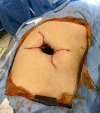Open window thoracostomy as an alternative approach to secondarily infected malignant pleural effusion and failure of intrapleural catheter drainage: a case report
- PMID: 30264008
- PMCID: PMC6155633
- DOI: 10.21037/acr.2018.03.05
Open window thoracostomy as an alternative approach to secondarily infected malignant pleural effusion and failure of intrapleural catheter drainage: a case report
Abstract
Malignant pleural effusion (MPE) is a common and complex manifestation of advanced stage cancer. Treatment options have trended towards less invasive approaches such as intrapleural catheter drainage, however this technique is not without morbidity and not suitable for every patient. A troublesome scenario arises when an MPE is secondarily infected in the setting of an indwelling catheter, given both the high frequency of recurrence of such fluid and the presence of a foreign body. Further, quality literature surrounding this specific management issue is sparse and thus practice is heterogeneous. Herein we presented a case report of a 74-year-old gentleman with secondarily infected MPE and subsequent failure of indwelling pleural catheter (IPC) drainage. Given multiple failures of his catheter, we performed an open window thoracostomy (OWT) to provide a durable method of draining the pleural space and concomitantly achieving source control. OWT represents an infrequently described but invaluable alternative measure the surgeon may take when faced with failure of intrapleural catheter drainage and trapped lung.
Keywords: Pleural effusion; empyema; lung neoplasms; malignant; thoracostomy.
Conflict of interest statement
Conflicts of Interest: The authors have no conflicts of interest to declare.
Figures



References
Publication types
LinkOut - more resources
Full Text Sources
Other Literature Sources
